

Rain Storms, Landuse, and Lake Turbidity. Credits Bill Mittlefeldt and Bruce Munson developed this lesson.

Goals Students will begin to understand the relationships between rainfall, landuse, and turbidity (suspended particulate material) in lakes. Introduction Storms can be significant events affecting turbidity readings in a lake. A portion of the rain that falls on the land in a watershed washes into the lake as runoff. G4U3L3 Ecosystem in a Bottle. STEMExplore Cabinet of Curiosities. Biomagnification. STEM-Water Filtration This is a STEM-Engineering Design Challenge lesson. Students will go through t ... Environmental Inquiry - Stormwater Design Challenge. Engineering Design Challenges Another form of interactive research is the design challenge, in which students apply skills in mathematical analysis, scientific inquiry, and technological design toward solving a specified problem within certain constraints.
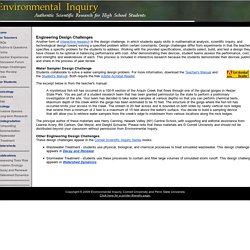
Design challenges differ from experiments in that the teacher specifies a specific problem for the students to address. Working with the provided specifications, students select, build, and test a design they have chosen to be optimal in balancing performance with cost. After demonstrating their devices, student teams assess the performance, cost, and strengths and weaknesses of each. This process is included in interactive research because the students demonstrate their devices publicly and share in the process of peer review. Grade 5 Water Protection from GBBR's Water Festival Learning Kit.
Access EEI - California Education and the Environment Initiative (EEI) Access all 85 California Education and the Environment Initiative (EEI) Curriculum units here!

Each EEI curriculum unit contains a combination of teacher, classroom and student components that are full of engaging lessons and informational texts. Please fill out our password request form to gain access to the Teacher’s Editions (TEs) of the EEI curriculum. TEs are password protected since they contain information intended for teachers and administrators only. EEI is California’s groundbreaking, first-in-the nation K-12 environmental education curriculum. Unit Details - California Education and the Environment Initiative (EEI) Graphing Analysis of Algae and Oysters. Exploring Biomass Pyramids. This activity is based on the fieldwork of ecologist Dr.
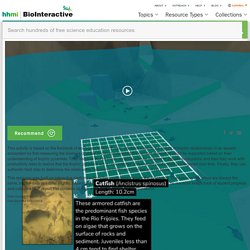
Mary Power. Students explore the nature of trophic relationships in an aquatic ecosystem by first measuring the biomass of algae and then estimating the number of fish that could be supported based on their understanding of trophic pyramids. They discover that biomass pyramids can be inverted in aquatic ecosystems and then they work with productivity rates to realize that the trophic pyramids are a conventional shape when productivity is integrated over time. Finally, they use authentic field data to determine the relationship between sunlight and biomass in river pools. Creating Chains and Webs to Model Ecological Relationships. Wolf reintro. iNaturalist Project & Curriculum. Outline On this page you will find the project summary and curriculum documents including student surveys, project outlines, assessments, webquests, field observation assignments, grading rubrics, and other related assignments.

Also, there is an iNaturalist PowerPoint for educators to train their students in using iNaturalist. Risingtidescience.wikispaces. Introduction to Ecology 2012-2013Rising Tide Charter Public SchoolMr.
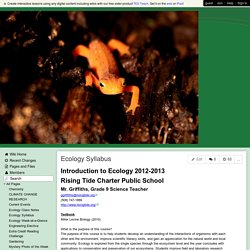
Griffiths, Grade 9 Science Teacherggriffiths@risingtide.org (508) 747- Miller Levine Biology (2010) What is the purpose of this course? The purpose of this course is to help students develop an understanding of the interactions of organisms with each other and the environment, improve scientific literacy skills, and gain an appreciation for the natural world and local community. Ecology is explored from the single species through the ecosystem level and the year concludes with applications to conservation and preservation of our ecosystems. RdP Invasive Guide Online. Charlie Chestnut. Resources: lesson plans, videos - Nature Works Everywhere. RaceToDisplace ABT201375310 Inquiry Investigations Hopwood. Environmental Science - Ms Kerrigan's Virtual Classroom. 06 coastal alien.
EcoEvo Ecological Interactions Kit TeacherHandout.
Home. Happiness Village - Pandas. San Jose: Leland High student uses the elements to create clean water, energy - Mercury News. By Anne Gelhaus, agelhaus@community-newspapers.com Posted: 08/10/2016 04:50:06 AM PDT | Updated: 2 days ago Leland High junior Jonathan Li, 16, spent a week at the University of Toronto this summer creating blueberry-based solar cells.
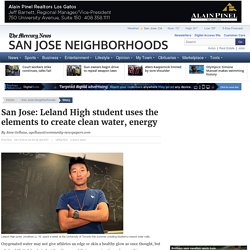
Population Ecology and Reproduction. Learn about population ecology on Lizard Island.
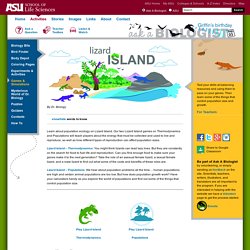
Our two Lizard Island games on Thermodynamics and Populations will teach players about the energy that must be collected and used to live and reproduce, as well as how different types of reproduction can affect population sizes. Lizard Island – Thermodynamics: You might think lizards can lead lazy lives. But they are constantly on the search for food to fuel life and reproduction.
Can you find enough food to make sure your genes make it to the next generation? Life Sciences Outreach at Harvard University. Looking For Biodiversity. This lesson plan may be used to address the academic standards listed below.
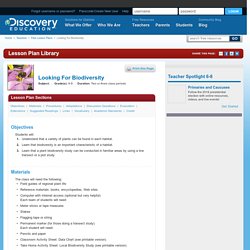
These standards are drawn from Content Knowledge: A Compendium of Standards and Benchmarks for K-12 Education: 2nd Edition and have been provided courtesy of theMid-continent Research for Education and Learningin Aurora, Colorado. Grade level: 6 - 8Subject area: Life ScienceStandard: Knows about the diversity and unity that characterize life.Benchmarks: Knows ways in which living things can be classified (e.g., taxonomic groups of plants, animals, and fungi; groups based on the details of organisms' internal and external features; groups based on the roles within an ecosystem, such as producers, consumers, and decomposers). Exploring biodiversity.
Www.pathwaysproject.kbs.msu.edu Blog. Biodiversity Teaching Materials » www.pathwaysproject.kbs.msu.edu Blog. Biodiversity: Research Professional Development Materials Assessments Scientist Leila Desotelle talks with students about stream macro-invertebrates at Kellogg Biological Station.
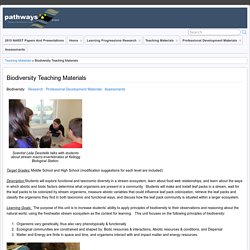
Target Grades: Middle School and High School (modification suggestions for each level are included) Description:Students will explore functional and taxonomic diversity in a stream ecosystem, learn about food web relationships, and learn about the ways in which abiotic and biotic factors determine what organisms are present in a community. Students will make and install leaf packs in a stream, wait for the leaf packs to be colonized by stream organisms, measure abiotic variables that could influence leaf pack colonization, retrieve the leaf packs and classify the organisms they find in both taxonomic and functional ways, and discuss how the leaf pack community is situated within a larger ecosystem. Plantdiversity. Ec3 Professional Development. Have you been working on school sustainability and looking to enrich and sharpen your skills and brainstorm with peers?
Are you passionate about educating for sustainability, but unsure about how to get your school more deeply engaged? Join us at NCTC. Work with national expertsGain skills and knowledge in sustainability leadership, implementation, and educationShare ideas and network with colleaguesExplore and enjoy NCTC's extraordinary campus on the Potomac River Foster awareness, education, and action throughout your school community About 30 professionals and educators interested in honing their sustainability skills toward becoming a more effective school sustainability leader. AP Environmental Science Sample Lesson Plans. Lesson Plans: 9th-12th Grade. Biodiversity. This section provides a background of what Biodiversity is, how you can help and what is happening at the University of Edinburgh.
What is Biodiversity? According to the Convention on Biodiversity (1992), "Biological diversity" means the variability among living organisms from all sources including... terrestrial, marine and other aquatic ecosystems and the ecological complexes of which they are part; this includes diversity within species, between species and of ecosystems. So, Biodiversity is actually all of the living things that surround us. Habitats teaching resources. Worksheets and lesson ideas to challenge students aged 11 to 16 to think hard about habitats, the environment and adaptations (GCSE and Key Stage 3) Habitats and adaptations of organisms GCSE and KS3 worksheet on adaptations and habitats. Students are given an imaginary scenario where various species have been washed up in different habitats of the World e.g. polar bears in the desert.
Students need to consider the various biotic and abiotic factors of the habitat and then explain why the organism is not adapted for that habitat. Do insects prefer local or foreign foods? Experiencing Air Pollution Through Inquiry.
Earth Day. Biodiversity and Climate Change. Ecology. Trout In The Classroom. High School Field Ecology Course. Coyote resources.